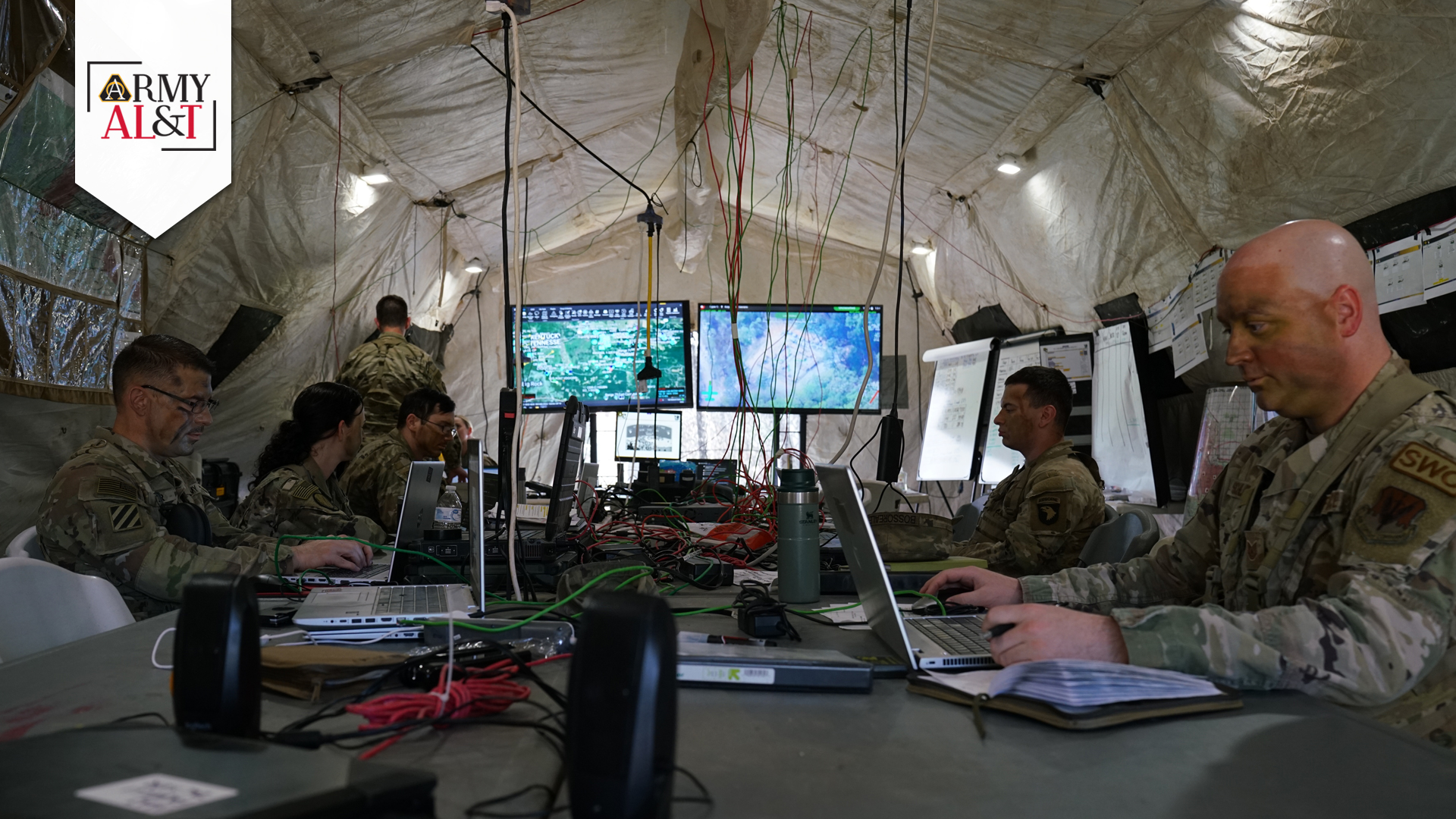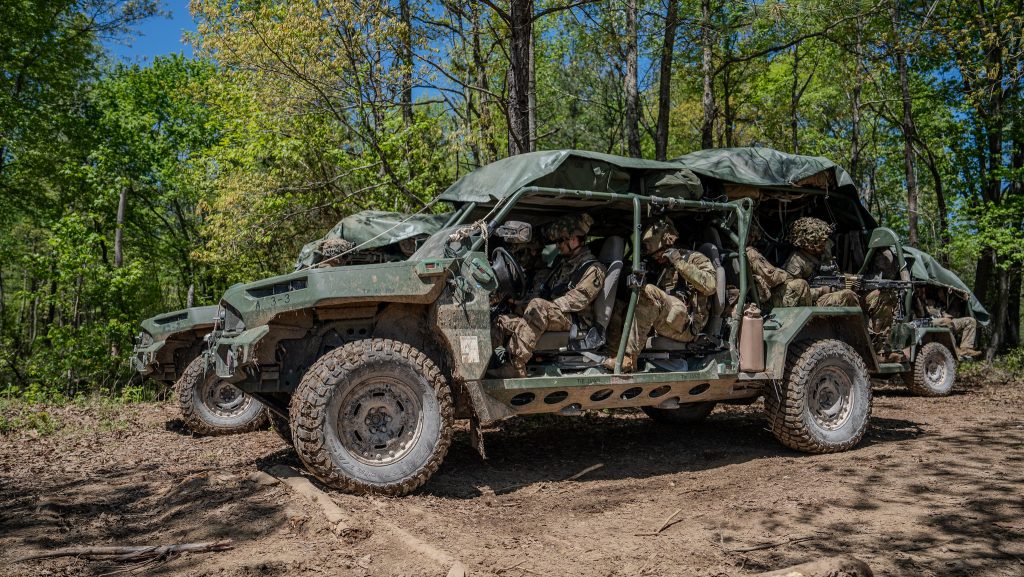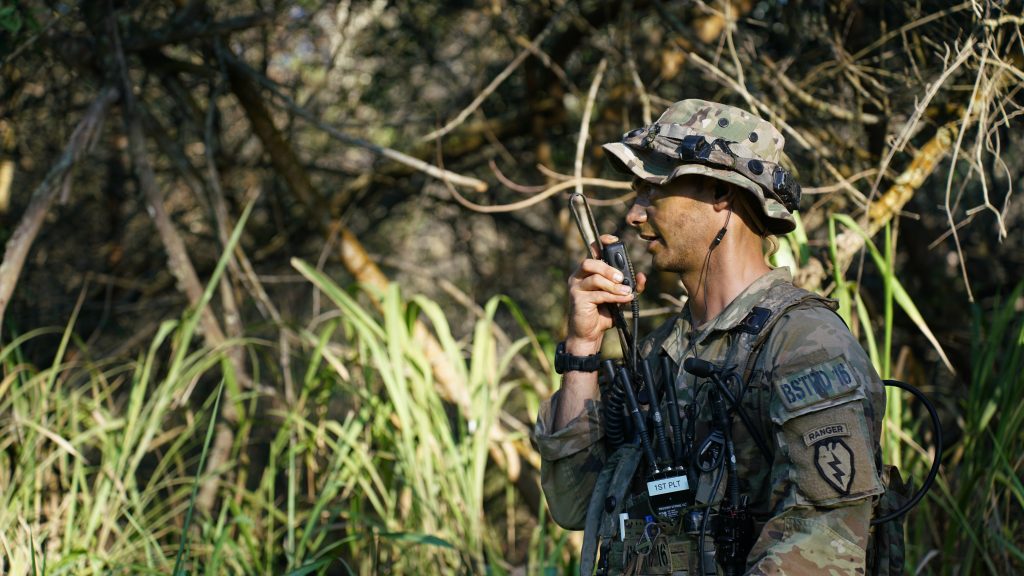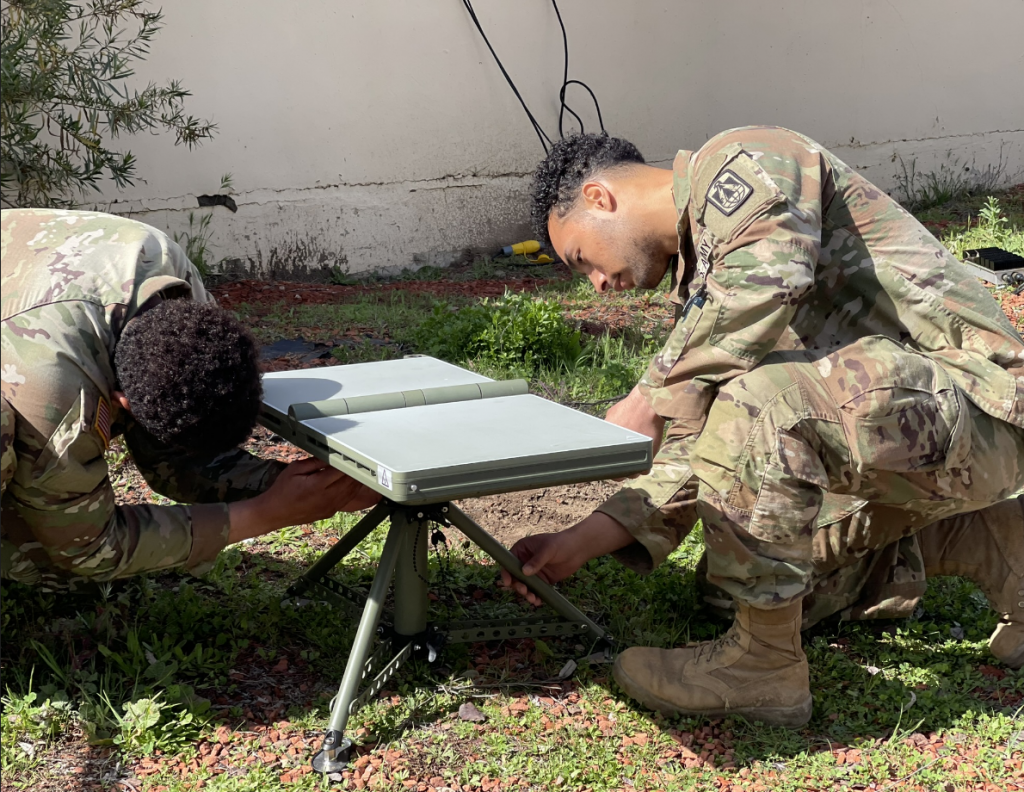
DIALED IN: Soldiers with the 101st Airborne (Air Assault) conduct mission command operations in the division command post during Operation Legal Eagle. The 21-day training exercise, held at Fort Campbell in April 2024, provided a backdrop to networked communications experimentation in support of the Army’s initiative to push network complexity from brigade up to division where appropriate for mission success. (Photo by Sam Brooks, U.S. Army)
The network is the top priority in the Army’s transformation effort, calling for systems that are more simple and intuitive.
by Maj. Bradley Anderson and Kathryn Bailey
The future operating environment will be complex, spanning great distances over extended timelines and noncontiguous regions and placing the Army’s network and command and control (C2) systems in the spotlight for every aspect of the fight. With so much riding on the communications of people and systems, Army senior leaders have designated the network as the No. 1 priority in the Army’s transformation effort, calling for systems that are more simple, intuitive, low-signature and iterative.
To ensure the network and its myriad radios, blue force tracking (GPS-enabled systems for tracking people and assets), command post, fires support technologies, satellite systems and other capabilities meet these requirements, the Army is identifying specific units to experiment with near-term networked communications systems designed to counter the threats leaders see evolving on the battlefield.
Known as “transforming in contact,” this experimentation is becoming an increasingly critical component for evaluating and helping to refine technologies that could be needed at a moment’s notice. U.S. Army Forces Command (FORSCOM) is supporting these assessments by providing a mix of light and armored formations across brigade combat teams, divisions and enablers.
Transforming in contact is not just for network experimentation; it is part of a larger Army initiative that is also evaluating electronic warfare, counter-unmanned aerial systems and how personnel and tactics align with technologies. Driven by Army Chief of Staff Gen. Randy A. George and other senior leaders, the transforming in contact effort spans regions and theaters in Europe, the Pacific and the Middle East as well as the continental U.S. In addition to FORSCOM units, the Army’s Centers of Excellence and program executive offices, as well as cross-functional teams from the Army Futures Command and other stakeholders are participating in these assessments to quickly translate operational feedback into action.
“The Soldier feedback process is not linear, so we rely on operational exercises, targeted experimentation and formal pilots to obtain the feedback the Army needs to make informed decisions,” said Program Executive Officer Mark Kitz, with the Program Executive Office for Command, Control and Communications – Tactical (PEO C3T), which leads the Army’s network and C2 portfolio.
To jump-start the new transformation effort from a network perspective, the Army chose the 101st Airborne Division (Air Assault) based at Fort Campbell, Kentucky, to experiment with multiple networked communications technologies. The unit used these systems before and during its third annual Operation Lethal Eagle exercise. Held in April 2024, it was designed to build Soldier and unit lethality and to assess the 2nd Brigade’s transformation from an infantry brigade combat team to a mobile brigade combat team. The brigade will continue to employ the systems at a Joint Readiness Training Center rotation later this year.
The 101st continues to provide comprehensive feedback on technology and organizational changes that may be needed to ensure the right skill set is at the right echelon to conduct the fight. At the division command post, for example, the unit is handling network architecture that was previously relegated to the brigade level. Additionally, aircraft pilots and dismounted Soldiers are finding new ways to communicate and share information during long-range air assaults.
“The division just completed the first comprehensive field assessment of the Army’s transformation in contact efforts by capitalizing on its unique training glide path to experiment with organizational change and inject modern capabilities at scale and under load,” said Maj. Paul Bingham, maneuver planner for the 101st Airborne Division (Air Assault).
“The timing was perfect, just based on where we were in our training, to take the newest thing and incorporate it,” said Col. Clinton Cody, Combat Aviation Brigade commander for the 101st. “We’ve been pushing the limits when it comes to large-scale combat operations … [and] we bring a unique perspective to the ground force and giving them that asymmetrical advantage.”

ALREADY GONE: The command team from 2nd Battalion, 502nd Infantry Regiment, 2nd Brigade Combat Team, 101st Airborne Division (Air Assault) conducts battlefield circulation during hasty defense and vehicle drop-off operations as part of Operation Lethal Eagle at Fort Campbell. The exercise tested systems designed to ensure that Soldiers are never in one place long enough to be seen, physically or through electronic signature. (Photo by Sgt. 1st Class Joseph Truesdale, 101st Airborne Division (Air Assault) Public Affairs)
COMMS ON-THE-MOVE
Army leaders have identified C2 on-the-move (OTM) as a critical enabler to increase survivability and provide commanders with the flexibility to fight and win against near-peer adversaries during multidomain and large-scale combat operations. (See “Command and Control On-The-Move” in the Spring 2024 issue of Army AL&T).
The critical first step to achieve C2 OTM has been aligned under the Command Post Integrated Infrastructure (CPI2) experimentation and limited user test, conducted with the 1-2 Stryker Brigade Combat Team, 7th Infantry Division at Joint Base Lewis McChord, Washington.
The CPI2 capability provides modular command post capability that integrates network and communications technologies, including the Integrated Tactical Network (ITN), into the family of medium tactical vehicle platforms, replacing existing tent-based command post capability.
“The conflict taking place in Europe continues to validate the need for mobile command posts,” said Lt. Col. Herb Gamble, CPI2 product manager within PEO C3T. “Mobility significantly increases survivability and it also provides the commander with the flexibility to command from anywhere in the fight.”
In 2023, the 1-2 Stryker Brigade Combat Team experimented with various vehicle types and sizes, from the smaller Humvees, which were used as a tactical command post, up to Mobile Command Platform Vehicles, which were used for more comprehensive command post functions such as intelligence and network operations.
The limited user test pushed the brigade combat team further onto the range, generating additional feedback on the need for onboard power versus a micro-grid, which required platforms to be tethered to a power source. The network program integration team installed generators on each vehicle platform in just two months. As a result, the unit now has more mobility to quickly emplace and displace vehicle-based command posts, which would increase survivability in a real-world operation.
Army leaders are now pushing for even greater mobility and less complexity at brigade level and below, citing the need to move the command post quickly and “hide in plain sight” from an electromagnetic signature perspective.
“We must have high-throughput, low-latency bandwidth and the ability to function in a dispersed environment, while minimizing electromagnetic signature,” Gamble said. “In addition to speed, we need to understand how our signatures appear in the electromagnetic spectrum to ensure we can’t be targeted.”
Today, PEO C3T’s CPI2 Program Office is integrating the 101st Airborne with networked mission command technologies and placing them at the division echelon, leaving the smaller, more tactical vehicles at brigade and below, as part of the C2 OTM transforming in contact effort.

ROGER THAT: Soldiers with the 3rd Brigade Combat Team, 25th Infantry Division complete an overnight assault mission during the Joint Pacific Multinational Readiness Center at Schofield Barracks, Hawaii, in November 2023. They provided feedback on the Army’s Division Warfighting at Echelon effort, which pushes network complexity up to division. (Photo by Samuel Brooks, PEO C3T Public Affairs)
BOOSTING SITUATIONAL AWARENESS
Until recently, the staple for blue force tracking and situational awareness in vehicles and the command post was the Joint Battle Command – Platform (JBC-P) hardware and software. The Army has begun upgrading the JBC-P software with the Mounted Mission Command – Software (MMC-S), relying heavily on experimentation efforts with the 2nd Brigade Combat Team, 82nd Airborne Division.
Unlike JBC-P, MMC-S provides an open software platform known as Tactical Assault Kit (TAK). “MMC-S is replacing JBC-P, utilizing a TAK baseline enabling the convergence of warfighting functions at a rapid pace, and leveraging Soldier feedback using a DevOps approach,” said Daniel Ghio, product manager for MMC within PEO C3T.
During the experimentation, the MMC program team did not wait for the traditional acquisition process; rather, it implemented Agile software practices and collaborated with other program offices, inserting industry partner technologies into the code and using multiple Soldier touch points with key stakeholders in attendance to obtain user input in real time.
The unit’s initial feedback after experimenting with the MMC-S in the field, which included a tablet integrated into the vehicle, indicated that the software was simple to use and provided a common look and feel from the vehicle to the command post. However, users wanted to be able to take the capability with them when transitioning to dismounted operations.
Program office developers took this feedback and provided the ability for the tablet to connect to any network point of presence in the formation, such as tactical radios, Wi-Fi and the upper tactical internet, giving dismounted troops the same common operating picture and chat function.
Soldier-driven feedback and the quick response from program developers for resolution provided the catalyst for the Office of the Director, Operational Test and Evaluation to deem the system effective, suitable and survivable. As a result, the system will be approved for full fielding in October 2024.
For the hardware, Mounted Mission Command – Transport (MMC-T) will replace the current legacy receiver to provide multitransport capabilities, such as low Earth orbit, geosynchronous Earth orbit and line-of-sight waveforms, which are critical to large-scale combat operations in contested and congested environments. The 11th Armored Cavalry Regiment at Fort Irwin, California, validated critical anti-jam and multipath diversity capabilities within the MMC-T during a Soldier touch point in January 2024. The MMC-T is moving into low-rate production in 2025.
The 2nd Brigade Combat Team relied on these lessons to incorporate the ITN and MMC-S into its brigade combat team maneuver experimentation, including Operation Lethal Eagle, enhancing on-the-move communications and helping to reduce the team’s footprint and electronic signature.
A MORE FLEXIBLE FIRES APPLICATION
The Advanced Field Artillery Tactical Data System (AFATDS) software, fielded by the Army in 1995, was the first system to fully automate support for planning, coordinating, controlling and executing fires and effects. Fast forward nearly 30 years to Project Convergence Capstone 4, held at Fort Irwin in February and March 2023. There, the Army conducted a demonstration of the Artillery Execution Suite (AXS) software, a modernized version of AFATDS, to replace the monolithic Fires C2 software with a TAK-based system. This new version is now undergoing Soldier experimentation at the division level with several units within the Army.
“While consistently effective throughout the years, AFATDS was not designed to be easily upgradable,” said Lt. Col. Timothy Godwin, product support manager for AFATDS.
The demonstration at Project Convergence showed that AFATDS and AXS could pass fires chain traffic back and forth, and both systems displayed the same common operating picture.
“AXS will be the flexible fires support software of the future and will be data-centric, hardware-agnostic and able to reside in the cloud,” Godwin said.
AIR ASSAULT COMMUNICATIONS
The ability of pilots and commanders to communicate with ground forces during air assaults provides an asymmetrical advantage to Soldiers in the fight. The 101st Airborne, which specializes in air assault operations, continues to provide critical feedback on the ITN Aviation Demonstration Kit. This capability puts the ITN, which is widely fielded across brigade combat teams, into the air for air-to-ground communications. Preceding the current experimentation with the 2nd Brigade Combat Team, 101st Airborne Division, the 25th Infantry Division’s Combat Aviation Brigade provided experimentation and feedback during its Joint Pacific Multinational Readiness Center rotation at Schofield Barracks, Hawaii, in November 2023.
The ITN Aviation Kit inserts a two-channel Leader Radio into the helicopter’s cockpit, providing the mesh network relay down to the dismounted Soldiers. The kit also includes a handheld tablet that provides text and chat functions for the pilot and commander to converse alongside radio communications.
Taking lessons learned from the 25th Infantry Division’s Combat Aviation Brigade, the PEO C3T program office for air-to-ground radios continues to experiment with support from the 2nd Brigade Combat Team, 101st Airborne Division. These efforts included the unit’s Joint Readiness Training Center rotation in January 2024, where nearly 80 helicopters conducted a 500-mile, large-scale, long-range air assault, from Fort Campbell to Fort Johnson, Louisiana, and back.
Better connectivity during such long-range, large-scale air assaults enables units to be task-organized and able to immediately share battlefield data when they hit the landing zone.
“The ‘Screaming Eagle’ Soldiers of the 101st demonstrated enthusiasm for utilizing the ITN Aviation communications package, [especially after] seeing their position location and information on their tablets and the ability to communicate via chat,” said Jerry Harper, product manager for Helicopters and Multi-Mission Radios for PEO C3T’s PM Tactical Radios.
The unit conducted a second long-range, large-scale air assault during Operation Lethal Eagle in April, taking off at night from Fort Campbell, flying to Camp Atterbury, Indiana, and then Fort Knox, Kentucky, before returning to Fort Campbell. The Army continues to collect lessons from this air assault as it provides guidance for additional kits and helps to refine the mesh network needed during the comprehensive, fast-moving, long-range air assault missions.
CONCLUSION
As the Army continues to experiment with increasing tactical mobility and survivability and pushing some of the more complex network communications systems up to division as part of transforming in contact, it is also ensuring that necessary capabilities remain at brigade level and below to enable commanders’ operational requirements. Soldier participation and feedback will ensure that the network architecture will support “fight tonight” missions as well as future needs.
“These Soldiers’ voices are being heard throughout the Army, from our program office up to the chief of staff of the Army, who has made the network and C2 systems the Army’s No. 1 priority for transformation,” Kitz said. “How these systems perform in the field, from ease of use to their functionality, carries a tremendous amount of weight for the Army to decide how it will conduct large-scale combat operations.”
For more information, contact the PEO C3T Public Affairs Office at 443-395-6489 or usarmy.APG.peo-c3t.mbx.pao-peoc3t@mail.mil. Go to https://go.usa.gov/xMSNz for the 2021 Army Unified Network Plan or follow PEO C3T at http://peoc3t.army.mil/c3t and https://www.facebook.com/peoc3t.
|
FEEDBACK ADVANCES SATCOM Implementing a Soldier feedback loop is a critical component in the Army’s efforts to enhance its Unified Network to support potential large-scale combat operations. The Army is leveraging Soldier feedback in two high-profile efforts to cost-effectively deliver the resilient, multi-orbit satellite communications (SATCOM) it needs to be successful in future conflicts. For several years, the Army has worked closely with commercial vendors through streamlined cooperative research and development agreements to securely integrate and explore the capabilities of emerging commercial low Earth orbit and medium Earth orbit satellite constellations, as well as the services and ground terminals needed to access them. As some of these commercial solutions mature and expand in global coverage, the Army is beginning to conduct operational assessments to inform near- and long-term network design decisions. Since September 2023, the 51st Expeditionary Signal Battalion-Enhanced (ESB-E) has supported an Army assessment to inform the potential integration of emerging high-throughput, low-latency (HT/LL) low Earth orbit commercial SATCOM into the Army’s expanding Unified Network transport arsenal. Recent geopolitical conflicts continue to underscore the need for commanders to possess multiple transport options to enhance their primary, alternate, contingency and emergency communication plans to ensure resilient, rapid and uninterrupted data exchange on the battlefield. The more network pathway options that exist for data to travel through—especially in disrupted, disconnected, intermittent and low-bandwidth environments—the more resilient the network becomes to signal roadblocks, including enemy jamming. The HT/LL assessment supported by the 51st ESB-E leverages several different maturing commercial low Earth orbit solutions integrated with the unit’s organic baseband systems. The purpose is to determine the best mix of solutions to potentially add HT/LL transport to the Army’s portfolio of SATCOM terminals. The assessment will also inform concept of operations and tactics, techniques and procedures for future HT/LL use in Army units. The unit will deploy and use the commercial assets in a variety of training exercises, mission sets and locations, and provide its feedback. The valuable quantitative and qualitative data points and Soldier feedback collected from the assessment will help shape Army HT/LL requirements and drive decisions on what to procure and how to implement materiel solutions to meet those requirements. Later this fiscal year, the Army plans to conduct a HT/LL medium Earth orbit assessment leveraging Scalable Class of Unified Terminal, or SCOUT, satellite terminals, to evaluate whether medium Earth orbit SATCOM could be a viable solution for transport diversity at division and above headquarters.  BASE OF OPERATIONS: Soldiers from the 86th Expeditionary Signal Battalion, 11th Corps Signal Brigade (CSB) and 11th CSB Network Operations take part in new equipment training in February 2023 at Camp Pendleton, California, as part of the Army’s SaaMS pilot program. (Photo by CW3 Nathan Paquette and CW2 Tim Gass, 11th CSB)  LINKED UP: PEO C3T’s Project Manager for Tactical Network facilitated new equipment training for the Virginia Army National Guard’s 529th Sustainment Support Battalion in February 2024 in North Chesterfield, Virginia. Feedback from the session will help shape Army HT/LL requirements and drive decisions on procurement and implementation. (Photo by Amy Walker, PEO C3T Public Affairs) SATCOM AS A MANAGED SERVICE Another pilot will inform Army decisions on a lease-versus-buy business model for acquiring and delivering scalable commercial SATCOM to support unit readiness and unique missions in future large-scale combat operations. To kick off the pilot, known as Satellite Communications as a Managed Service (SaaMS), the Army fielded different bundled commercial equipment, bandwidth and service packages to units in several regional coverage areas around the globe. Instead of the Army having to procure, field, sustain and modernize equipment on its own for every unit and every mission, SaaMS could enable the Army to lease these capabilities at the point of need. This business model would be scalable to expand or contract as missions change, helping to reduce on-hand inventory, satellite airtime and cost. SaaMS would ensure bandwidth is allocated at the right place and time to support data exchange in a wide variety of mission sets. As PEO C3T released in April 2024, Army will leverage the data and Soldier feedback from the pilot and other DOD efforts to make informed decisions on implementing SaaMS to meet the increasing demand for secure reliable SATCOM. In line with the Army Unified Network Plan, a SaaMS model could potentially help the service to more affordably keep up with the accelerating speed of technology advancement, while reducing equipment obsolescence and other sustainment challenges. Solutions will be flexible and tailorable to meet the needs of specific mission sets and enable SATCOM connectivity and hardware to be surged for deployments or humanitarian assistance and disaster relief missions. The SaaMS pilot encompasses commercial capability in both low Earth orbit and the traditional geosynchronous Earth orbit constellations. Leveraging SaaMS’ multivendor, multi-orbit SATCOM capability could fuel the Army’s efforts to enhance network resiliency through transport diversity, especially in denied, degraded, intermittent and limited-bandwidth environments. The intent of the pilot is not to create a separate SaaMS evaluation event, but to enable operational units to use the different service and equipment sets to best suit their individual needs and roll them into their existing training events through fiscal year 2024. During the pilot, the Army is assessing varying degrees of leased end-to-end service models with tailorable features that include satellite terminals, bandwidth capacity, security compliance, logistics and repair. The pilot also encompasses different scenarios, such as using SaaMS to provide a stopgap for maintenance issues due to obsolescence or to rapidly deliver the “latest and greatest” in commercial technology to an Army National Guard unit before a deployment, said Seth Chouinard, SaaMS project lead for Product Manager for Unified Network Capabilities and Integration. Alongside the pilot, the Army is accelerating the potential use of an “as a service” business model by concurrently using lessons learned from other DOD efforts in the managed services realm, including those conducted by the U.S. Navy and U.S. Marine Corps. Similarly, the Army is looking into the potential of leveraging a commercial “as a service” model for tactical radios, releasing a request for information to industry to gain further insight. To further examine the pros and cons of the SaaMS model, the Army is working with Johns Hopkins University to conduct a SaaMS business case and cost analysis to aid in future lease-versus-buy decisions. —LT. COL. MARK SCOTT & AMY WALKER |
MAJ. BRADLEY ANDERSON is the assistant product manager for Helicopters and Multi-Mission Radios within PM Tactical Radios. He joined the Army Acquisition Corps in 2022 after completing the Army Acquisition Professional Course and has served in a variety of assistant product manager positions across the Tactical Radio portfolio. He holds a B.S. in criminal justice from Old Dominion University.
KATHRYN BAILEY is the public communications specialist for Bowhead Business and Technologies Solutions, assigned to PEO C3T, where she has covered PM Tactical Radios for the past six years, including the ITN effort and Army, joint and coalition fielding and training events worldwide. She holds a B.A. in communications studies from the University of Maryland Global Campus.







